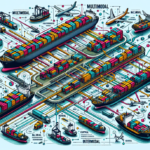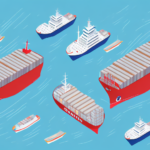Maximizing Efficiency with Multimodal Shipping
In today's highly interconnected world, businesses rely on a variety of transportation modes to move goods efficiently and cost-effectively. One innovative approach that is gaining increasing popularity is multimodal shipping. Multimodal shipping is defined as the use of two or more modes of transportation for the movement of cargo from origin to destination. The different modes utilized can include road, rail, air, sea, and inland waterways. As a comprehensive logistics solution, multimodal transportation offers businesses significant advantages in cost optimization, reduced handling time, improved security, and flexibility.
What is Multimodal Shipping and How It Works
Multimodal shipping is an organized approach to cargo movement that leverages the strengths of different transportation modes in a seamless and coordinated manner to deliver goods efficiently and quickly. It works through the integration of various modes of transportation into a single, streamlined process, often under the management of a single logistics provider. This approach ensures that the shipment is designed to minimize costs, avoid delays, and maximize the efficiency and speed of cargo movement. Typically, logistics providers operate under a single contractual agreement, allowing the multimodal transportation process to be completed without any disruptions.
One of the key benefits of multimodal shipping is its flexibility. It allows shippers to choose the most appropriate mode of transportation for their cargo, depending on factors such as the type of goods, the distance to be covered, and the urgency of delivery. For example, a shipment may start by truck, then move to rail, and finally be delivered by ship. This flexibility enables shippers to adapt to changing market conditions and respond quickly to customer demands.
Another advantage of multimodal shipping is its environmental sustainability. By using different modes of transportation, shippers can reduce their carbon footprint and minimize the impact of their operations on the environment. For instance, rail transport is known to be more energy-efficient and emit fewer greenhouse gases than road transport[1]. By combining different modes of transportation, shippers can optimize their logistics operations and reduce their overall environmental impact.
Advantages of Using Multimodal Shipping for Your Business
For companies involved in global trade, the advantages offered by multimodal transportation cannot be ignored. By leveraging a range of transportation modes, businesses can realize significant efficiencies, faster shipping times, greater flexibility, and lower costs. Multimodal shipments can help optimize transportation budgets by eliminating redundant costs and reducing shipping delays[2]. This approach also offers more flexibility regarding delivery options, as cargo can be transported to inland destinations that may not have direct access to ports.
Another advantage of multimodal shipping is that it can help reduce the environmental impact of transportation. By using a combination of transportation modes, businesses can lower their carbon footprint and contribute to a more sustainable supply chain. Additionally, multimodal shipping can help mitigate the risks associated with transportation disruptions, such as natural disasters or labor strikes. Having multiple transportation options available allows businesses to quickly adapt to changing circumstances and ensure that their shipments reach their destination on time.
Finally, multimodal shipping can also improve the overall customer experience. By offering faster shipping times and more flexible delivery options, businesses can provide a higher level of service to their customers. This can lead to increased customer satisfaction and loyalty, as well as a competitive advantage in the marketplace. Overall, the benefits of multimodal shipping make it a smart choice for businesses looking to optimize their supply chain and improve their bottom line.
Understanding the Different Modes of Transportation Involved in Multimodal Shipping
The transportation modes that typically lead to multimodal shipping include road (trucking), rail, air, sea, and inland waterways. The mode chosen for a particular shipment may depend on the cargo type, cargo weight, shipping destination, origin location, and budget. Each mode of transportation offers its benefits and drawbacks, and the options are analyzed to find the best fit for the shipment.
- Road Transportation: Often used for shipments within the same city or when shipping to destinations where other modes cannot travel. It offers flexibility and door-to-door service.
- Rail Transportation: Ideal for moving bulk goods quickly and efficiently over long distances. Rail is cost-effective and environmentally friendly for large shipments.
- Air Transportation: Suitable for shipments that require very fast delivery or need to reach a remote location quickly. It is the most expensive mode but offers unparalleled speed.
- Sea Transportation: Typically used for the shipment of large quantities of goods over long distances. It is cost-effective for heavy and bulky items.
- Inland Waterways: Used to transport goods between water bodies, such as rivers or lakes. It is efficient for bulk goods and reduces road congestion.
Another important factor to consider when choosing a mode of transportation is the environmental impact. Road transportation is often the least environmentally friendly option, as it contributes to air pollution and traffic congestion. Rail transportation is a more sustainable option, producing fewer emissions and moving large quantities of goods at once. Sea transportation is also relatively sustainable, as it produces fewer emissions per unit of cargo than other modes of transportation[3].
Finally, it is important to consider the cost of each mode of transportation. While air transportation may be the fastest option, it is also typically the most expensive. Road transportation may be the cheapest option for short distances but can become more expensive for longer distances. Rail and sea transportation are often the most cost-effective options for long-distance shipments, but they may take longer to reach their destination. Ultimately, the choice of transportation mode will depend on a variety of factors, and it is important to carefully consider each option before making a decision.
Planning and Coordinating Multimodal Shipments for Optimal Efficiency
Multimodal shipping is a complex process that requires careful planning, coordination, and execution. To ensure maximum efficiency, it is essential to conduct a detailed review of all cargo types to determine the best combination of transportation modes. This involves selecting the right carrier and transportation mode, planning the optimal route, and managing all legal and regulatory requirements. Considerations include transit times, customs requirements, cargo insurance, and handling processes across multiple time zones and geographical locations. Properly executing these activities can help companies reduce operational complexity, minimize transportation costs, and improve overall efficiency.
One of the key challenges in multimodal shipping is managing the handover of cargo between different transportation modes. This requires careful coordination and communication between carriers to ensure that the cargo is transferred safely and efficiently. It's also important to consider the compatibility of different transportation modes, such as ensuring that cargo can be easily transferred between trucks and trains. By addressing these challenges, companies can optimize their multimodal shipping operations and achieve greater efficiency and cost savings.
Tips for Choosing the Right Carrier and Freight Forwarder for Your Multimodal Shipment
Choosing the right carrier and freight forwarder are critical steps to a successful multimodal shipment. The carrier should possess the right equipment, technology, and experience for the modes of transportation involved in shipping. A freight forwarder should have an extensive network of carriers, expertise in handling complex logistics, deep knowledge of local regulations and customs procedures, and an advanced tracking system to monitor cargo movements.
Another important factor to consider when choosing a carrier and freight forwarder is their reputation in the industry. Look for companies with a proven track record of delivering shipments on time and in good condition. You can also check online reviews and ask for references from other businesses that have used their services.
It's also essential to consider the cost of shipping when selecting a carrier and freight forwarder. While you don't want to compromise on quality, you also don't want to overspend on shipping costs. Compare quotes from different companies and negotiate rates to ensure you're getting the best value for your money.
Overcoming Challenges in Multimodal Shipping: Solutions and Best Practices
Despite the advantages offered by multimodal shipping, there are also challenges that need to be navigated. These include managing logistics across various modes of transportation, coordinating with multiple transportation providers, dealing with regulatory compliance, ensuring timely delivery, and managing cargo safety, among others. To overcome these challenges, companies can implement best practices such as:
- Engaging an integrated transport management system
- Collaborating with well-established logistics providers with global supply chains
- Leveraging adequate insurance coverage
- Establishing a contingency plan to mitigate problems in transport
Another challenge that companies face in multimodal shipping is the lack of visibility and transparency in the supply chain. With multiple transportation providers involved, it can be difficult to track the movement of goods and ensure that they are delivered on time. To address this challenge, companies can use technology solutions such as GPS tracking, real-time monitoring, and data analytics to gain visibility into the supply chain and identify potential bottlenecks. By leveraging these tools, companies can improve their operational efficiency, reduce costs, and enhance customer satisfaction.
Innovations and Technological Advancements in the Multimodal Shipping Industry
The transportation industry has seen many innovative technologies and advancements over the years. For example, the use of blockchain technology for smart contracts and cargo tracking purposes, automation technologies, the development of autonomous trucks and drones, electrification of ships, and the widespread adoption of artificial intelligence (AI) applications. These advancements can help companies predict and optimize their supply chains, reduce transportation costs, and improve customer service experiences by offering real-time shipment tracking and status updates[4].
Environmental Benefits of Using Multimodal Shipping
The multimodal transportation approach is also beneficial to the environment. By using a combination of transportation modes, the overall environmental impact can be significantly reduced. For example, sea and inland waterway transportation produce significantly lower emissions compared to road and air transportation[5]. Multimodal shipping can help to reduce the overall carbon footprint of the supply chain, leading to a more sustainable approach to transportation management.
Trends and Future Predictions for the Multimodal Shipping Industry
The multimodal shipping industry is constantly evolving and is poised for further advancements in the future. Innovative solutions such as increased collaboration between providers, digitization, and the incorporation of 3D printing in logistics operations, among other emerging trends, are likely to set a pace for more streamlined and efficient logistics transportation in the future. Increased use of technology will enable end-to-end transparency, improved supply chain agility, and allow shippers to have a better and complete overview of variables such as delivery lead times and costs before choosing the optimal transit route and transportation mode.
In Conclusion
As trade and commerce continue to expand globally, businesses are increasingly turning to multimodal shipping to maximize efficiency and reduce costs. This comprehensive approach offers several advantages, including access to a range of transportation modes, easier coordination between shipments, and reduced operational complexity. However, this strategy is not without its challenges, including the need to overcome regulatory hurdles and manage transportation across multiple modes. Nevertheless, with proper planning, coordination, and execution, companies can leverage the benefits of multimodal shipping to realize significant growth potential in their respective industries.
For further reading and authoritative insights on multimodal shipping, refer to resources from the U.S. Department of Transportation, the International Civil Aviation Organization, and the International Transport Forum.






















